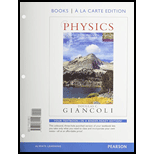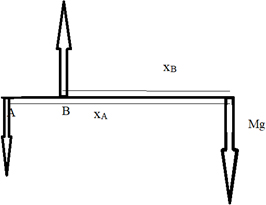
Physics: Principles with Applications, Books a la Carte Edition & Modified Mastering Physics with Pearson eText -- ValuePack Access Card Package
1st Edition
ISBN: 9780321974990
Author: Douglas C. Giancoli
Publisher: PEARSON
expand_more
expand_more
format_list_bulleted
Concept explainers
Question
Chapter 9, Problem 1OQ
To determine
The force exerted on the diving board at A and B.
Expert Solution & Answer
Answer to Problem 1OQ
Solution:
Option (a)FA is down, FB is up and FB is larger than FA.
Explanation of Solution
Torque can be understood as a force that tends to cause rotation.
Weight of the diver will act downwards. The reaction forces will act upwards at A and B.

Want to see more full solutions like this?
Subscribe now to access step-by-step solutions to millions of textbook problems written by subject matter experts!
Students have asked these similar questions
A pendulum has a 0.4-m-long cord and is given a tangential velocity of 0.2 m/s toward the
vertical from a position 0 = 0.3 rad.
Part A
Determine the equation which describes the angular motion.
Express your answer in terms of the variable t. Express coefficients in radians to three significant figures.
ΜΕ ΑΣΦ
vec
(t)=0.3 cos (4.95t) + 0.101 sin (4.95t)
Submit Previous Answers Request Answer
× Incorrect; Try Again; 6 attempts remaining
Part A
■Review
The uniform 150-lb stone (rectangular block) is being turned over on its side by pulling the
vertical cable slowly upward until the stone begins to tip.
(Figure 1)
If it then falls freely (T = 0) from an essentially balanced at-rest position, determine the speed at which the corner A strikes the pad at B. The stone does not slip at its corner C as it falls. Suppose that height of the stone is
L = 1.2 ft.
Express your answer to three significant figures and include the appropriate units.
?
ft
VA 10.76
S
Submit Previous Answers Request Answer
× Incorrect; Try Again; 6 attempts remaining
Consider the circuit shown in the figure. The battery has emf ε = 69 volts and negligible internal resistance. The inductance is L = 0.4 H and the resistances are R 1 = 12 Ω and R 2 = 9.0 Ω. Initially the switch S is open and no currents flow. Then the switch is closed. After leaving the switch closed for a very long time, it is opened again. Just after it is opened, what is the current in R 1?
Chapter 9 Solutions
Physics: Principles with Applications, Books a la Carte Edition & Modified Mastering Physics with Pearson eText -- ValuePack Access Card Package
Ch. 9 - Prob. 1OQCh. 9 - Describe several situations in which an object is...Ch. 9 - Prob. 2QCh. 9 - You can find the center of gravity of a meter...Ch. 9 - Prob. 4QCh. 9 - A ground retaining wall is shown in Fig. 9-36a...Ch. 9 - Can the sum of the torques on an object be zero...Ch. 9 - A ladder, leaning against a wall, makes a 60°...Ch. 9 - A uniform meter stick supported at the 25-cm mark...Ch. 9 - Why do you tend to lean backward when carrying a...
Ch. 9 - Figure 9-38 shows a cone. Explain how to lay it on...Ch. 9 - Prob. 11QCh. 9 - Why is it not possible to sit upright in a chair...Ch. 9 - Why is it more difficult to do sit-ups when your...Ch. 9 - Explain why touching your toes while you are...Ch. 9 - Prob. 15QCh. 9 - Name the type of equilibrium for each position of...Ch. 9 - (
17.
)
Is the Young's modulus for a bungee cord...Ch. 9 - Prob. 18QCh. 9 - Prob. 19QCh. 9 - A 60-kg woman stands on the very end of a uniform...Ch. 9 - Prob. 2MCQCh. 9 - Prob. 3MCQCh. 9 - Prob. 4MCQCh. 9 - Two children are balanced on opposite sides of a...Ch. 9 - Prob. 6MCQCh. 9 - Prob. 7MCQCh. 9 - Prob. 8MCQCh. 9 - Prob. 9MCQCh. 9 - Prob. 10MCQCh. 9 - Three forces are applied to a tree sapling, as...Ch. 9 - Prob. 2PCh. 9 - 3(I) A tower crane ( Fig. 9-48a) must always be...Ch. 9 - What is the mass of the diver in Fig. 9-49 if she...Ch. 9 - Prob. 5PCh. 9 - Figure 9-50 shows a pair of forceps used to hold a...Ch. 9 - Prob. 7PCh. 9 - The two trees in Fig. 9-51 are 6.6 m apart. A...Ch. 9 - Prob. 9PCh. 9 - Prob. 10PCh. 9 - Prob. 11PCh. 9 - Find the tension in the two cords shown in Fig....Ch. 9 - Prob. 13PCh. 9 - Prob. 14PCh. 9 - The force required to pull the cork out of the top...Ch. 9 - Prob. 16PCh. 9 - Three children are trying to balance on a seesaw,...Ch. 9 - A shop sign weighing 215 N hangs from the end of a...Ch. 9 - Prob. 19PCh. 9 - Prob. 20PCh. 9 - Prob. 21PCh. 9 - 22 (II) A 20.0-m-long uniform beam weighing 650 N...Ch. 9 - Prob. 23PCh. 9 - Prob. 24PCh. 9 - Prob. 25PCh. 9 - Prob. 26PCh. 9 - A uniform rod AB of length 5.0 m and mass M=3.S kg...Ch. 9 - You are on a pirate ship and being forced to walk...Ch. 9 - Prob. 29PCh. 9 - Prob. 30PCh. 9 - Prob. 31PCh. 9 - Prob. 32PCh. 9 - Prob. 33PCh. 9 - Prob. 34PCh. 9 - Prob. 35PCh. 9 - 36 (II) The Achilles tendon is attached to the...Ch. 9 - If 25 kg is the maximum mass m that a person can...Ch. 9 - Prob. 38PCh. 9 - Prob. 39PCh. 9 - Prob. 40PCh. 9 - A marble column of cross-sectional area 1.4 m2...Ch. 9 - Prob. 42PCh. 9 - A sign (mass 1700 kg) hangs from the bottom end of...Ch. 9 - Prob. 44PCh. 9 - Prob. 45PCh. 9 - Prob. 46PCh. 9 - A steel wire 2.3 mm in diameter stretches by...Ch. 9 - Prob. 48PCh. 9 - Prob. 49PCh. 9 - Prob. 50PCh. 9 - Prob. 51PCh. 9 - Prob. 52PCh. 9 - (a) What is the minimum cross-sectional area...Ch. 9 - Prob. 54PCh. 9 - Prob. 55PCh. 9 - Prob. 56PCh. 9 - Prob. 57PCh. 9 - Prob. 58GPCh. 9 - Prob. 59GPCh. 9 - Prob. 60GPCh. 9 - Prob. 61GPCh. 9 - Prob. 62GPCh. 9 - Prob. 63GPCh. 9 - Prob. 64GPCh. 9 - When a mass of 25 kg is hung from the middle of a...Ch. 9 - Prob. 66GPCh. 9 - Prob. 67GPCh. 9 - Prob. 68GPCh. 9 - Prob. 69GPCh. 9 - Prob. 70GPCh. 9 - Prob. 71GPCh. 9 - Prob. 72GPCh. 9 - Prob. 73GPCh. 9 - A 2.0-m-high box with a 1.0-m-square base is moved...Ch. 9 - Prob. 75GPCh. 9 - Prob. 76GPCh. 9 - Prob. 77GPCh. 9 - Prob. 78GPCh. 9 - In a mountain-climbing technique called the...Ch. 9 - Prob. 80GPCh. 9 - A cubic crate of side s=20m is top-heavy: its cgis...
Knowledge Booster
Learn more about
Need a deep-dive on the concept behind this application? Look no further. Learn more about this topic, physics and related others by exploring similar questions and additional content below.Similar questions
- A capacitor with a capacitance of C = 5.95×10−5 F is charged by connecting it to a 12.5 −V battery. The capacitor is then disconnected from the battery and connected across an inductor with an inductance of L = 1.55 H . At the time 2.35×10−2 s after the connection to the inductor is made, what is the current in the inductor? At that time, how much electrical energy is stored in the inductor?arrow_forwardCan someone help me with this question. Thanks.arrow_forwardCan someone help me with this question. Thanks.arrow_forward
arrow_back_ios
SEE MORE QUESTIONS
arrow_forward_ios
Recommended textbooks for you
 College PhysicsPhysicsISBN:9781305952300Author:Raymond A. Serway, Chris VuillePublisher:Cengage Learning
College PhysicsPhysicsISBN:9781305952300Author:Raymond A. Serway, Chris VuillePublisher:Cengage Learning University Physics (14th Edition)PhysicsISBN:9780133969290Author:Hugh D. Young, Roger A. FreedmanPublisher:PEARSON
University Physics (14th Edition)PhysicsISBN:9780133969290Author:Hugh D. Young, Roger A. FreedmanPublisher:PEARSON Introduction To Quantum MechanicsPhysicsISBN:9781107189638Author:Griffiths, David J., Schroeter, Darrell F.Publisher:Cambridge University Press
Introduction To Quantum MechanicsPhysicsISBN:9781107189638Author:Griffiths, David J., Schroeter, Darrell F.Publisher:Cambridge University Press Physics for Scientists and EngineersPhysicsISBN:9781337553278Author:Raymond A. Serway, John W. JewettPublisher:Cengage Learning
Physics for Scientists and EngineersPhysicsISBN:9781337553278Author:Raymond A. Serway, John W. JewettPublisher:Cengage Learning Lecture- Tutorials for Introductory AstronomyPhysicsISBN:9780321820464Author:Edward E. Prather, Tim P. Slater, Jeff P. Adams, Gina BrissendenPublisher:Addison-Wesley
Lecture- Tutorials for Introductory AstronomyPhysicsISBN:9780321820464Author:Edward E. Prather, Tim P. Slater, Jeff P. Adams, Gina BrissendenPublisher:Addison-Wesley College Physics: A Strategic Approach (4th Editio...PhysicsISBN:9780134609034Author:Randall D. Knight (Professor Emeritus), Brian Jones, Stuart FieldPublisher:PEARSON
College Physics: A Strategic Approach (4th Editio...PhysicsISBN:9780134609034Author:Randall D. Knight (Professor Emeritus), Brian Jones, Stuart FieldPublisher:PEARSON

College Physics
Physics
ISBN:9781305952300
Author:Raymond A. Serway, Chris Vuille
Publisher:Cengage Learning

University Physics (14th Edition)
Physics
ISBN:9780133969290
Author:Hugh D. Young, Roger A. Freedman
Publisher:PEARSON

Introduction To Quantum Mechanics
Physics
ISBN:9781107189638
Author:Griffiths, David J., Schroeter, Darrell F.
Publisher:Cambridge University Press

Physics for Scientists and Engineers
Physics
ISBN:9781337553278
Author:Raymond A. Serway, John W. Jewett
Publisher:Cengage Learning

Lecture- Tutorials for Introductory Astronomy
Physics
ISBN:9780321820464
Author:Edward E. Prather, Tim P. Slater, Jeff P. Adams, Gina Brissenden
Publisher:Addison-Wesley

College Physics: A Strategic Approach (4th Editio...
Physics
ISBN:9780134609034
Author:Randall D. Knight (Professor Emeritus), Brian Jones, Stuart Field
Publisher:PEARSON
What is Torque? | Physics | Extraclass.com; Author: Extraclass Official;https://www.youtube.com/watch?v=zXxrAJld9mo;License: Standard YouTube License, CC-BY